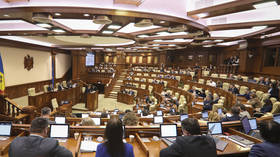US liquefied natural gas exports down by a third as coronavirus pandemic crushes global demand
US natural gas exports are starting to run into trouble, with dozens of shipments canceled because of weak demand.
Roughly 45 LNG cargoes scheduled for export in July from US ports were recently canceled by customers, according to S&P Global Platts. About half of them are connected Cheniere Energy’s two export terminals on the Gulf Coast.
The cancellations are about twice as high for July as they are for June. That puts the volume of gas exported from the US down by about a third, according to Platts.
As is the case with the oil market, the global market for natural gas is suffering under the weight of the pandemic, with a sharp decrease in demand. But some of the conditions are different between gas and oil.
A wave of additional LNG supply in 2019 depressed the market even before the global economic downturn.
LNG prices in Asia have been trading at extremely low levels for months, but the pandemic has pushed prices down even further. The Platts JKM marker – LNG prices in East Asia – fell to $2.125/MMBtu for July delivery.
At those prices, spot margins are in negative territory, according to Platts. With Henry Hub prices trading at around $1.70/MMBtu, the cost of liquefaction and transport – a few additional dollars per MMBtu – means that it is not profitable to export.
However, for many exporters, their shipments are tied up in fixed long-term contracts at higher prices. That insulates them a bit. But the rising rate of cancellations suggest that buyers are willing to pay a penalty to get out of those obligations – a sign of a badly oversupplied market.
“Current forward prices indicate that US LNG is out of the money through at least September. Additional cargo cancellations will follow,” Matthew Shruhan, senior analyst at IHS Markit, said in a statement. The firm said that the “process by which this turndown in US LNG output will balance the global market will not be smooth.”
IHS dubbed the US a new “swing producer” of LNG, which carries an overly positive connation. That’s just a fancy way of saying that US LNG is the least durable during a downturn; the quickest to get shut in. When the world sees oversupply and low market prices demand curtailments, US cargoes are at risk of going offline first.
Of course, the story doesn’t end there. Canceled LNG cargoes means less demand for the underlying gas itself. Goldman Sachs laid out a hypothetical scenario in which an additional 1 billion cubic feet per day (Bcf/d) of US LNG exports suffering cancellation would translate into a surge of gas diverted into storage, which in turn, leads to a $0.40/MMBtu decline in Henry Hub natural gas prices.
But the downward pricing pressure could be “offset by lower-than-expected production,” Goldman analysts wrote in a May 20 report. Translation: LNG cargoes getting canceled could force shale gas drillers to cut back on production.
Meanwhile, in a separate report, investment bank Morgan Stanley said that the LNG market is shifting into a world of “structurally lower prices.”
Also on rt.com LNG price war could send natural gas into negative territory
“After declining ~40% in 2019, prices in Europe and Asia have fallen another 55-60% year-to-date,” the bank wrote, a negative backdrop that was set before the global pandemic. “Consistent with our expectations, the combination of mild weather and demand loss from Covid-19 has added further pressure to an already fragile 2020 setup.”
Not only are prices lower, but the differentials between prices in various parts of the globe are much narrower. That upends the whole logic of liquefying gas in one part of the world, shipping it around the globe where it can be turned back into gas and burned.
“Longer term, the collapse in oil prices has caused a wave of capex cuts and LNG project delays, substantially reducing the likely project sanctioning over the next 1-2 years,” Morgan Stanley added. The bank said the supply overhang could begin to dissipate in 2022, moving closer to something resembling a balance.
But others see a more long-term pullback in investment. “We don’t see any additional North American export capacity getting sanctioned in the next decade,” Ross Wyeno, an LNG analyst at S&P Global Platts, told the FT.
By Nick Cunningham of Oilprice.com















